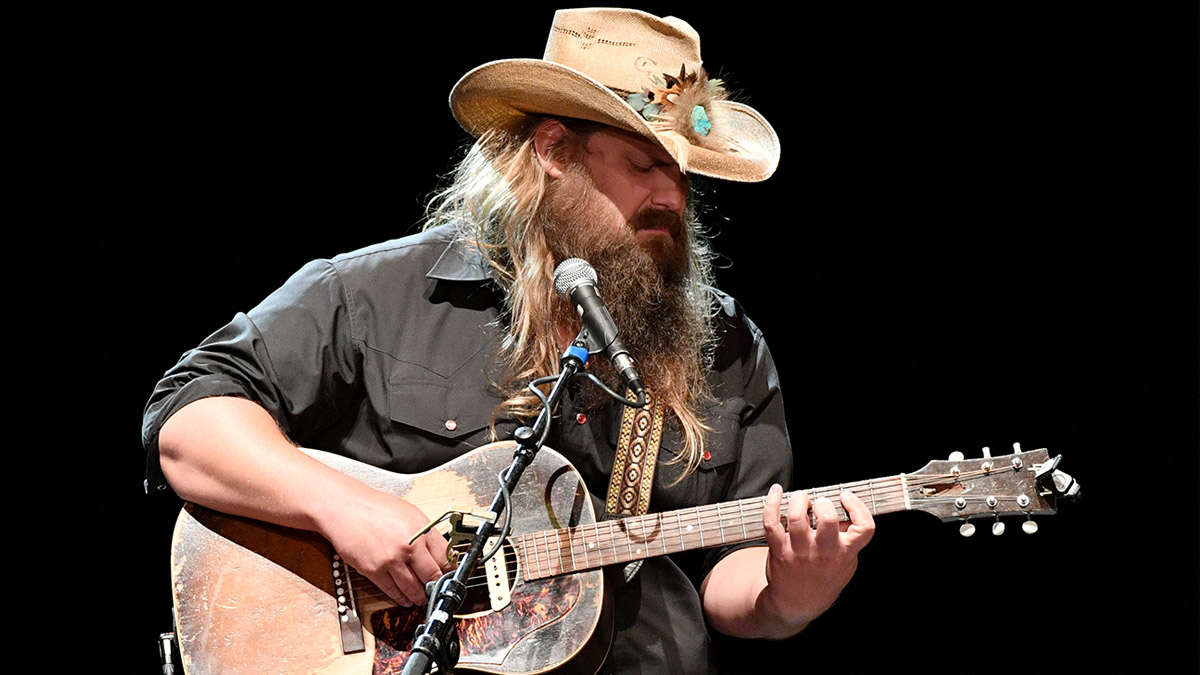
One of the biggest stars in today’s country scene, songwriter-guitarist Chris Stapleton is a great example of an artist who not only writes great songs but great guitar parts too.
Whereas many modern songwriters simply strum chords or hire A list session players to take care of guitar duties, Stapleton’s parts are interesting and memorable… and all created and played by him!
Most musicians gravitate to Nashville to kickstart their musical career as a session player or songwriter. Stapleton’s impetus for his Nashville move was actually to study an engineering degree! Thankfully for we listeners his songwriting took precedence over studies and he soon signed a publishing deal that set him on his way.
His performing career started in 2007 when he joined Bluegrass group The Steeldrivers. But by 2010 his focus had shifted to a country-rock sound as he formed a new band, The Jompson Brothers. In 2013 he signed with Mercury Nashville and embarked on the solo career that was to make him a star.
Although commonly seen toting a Fender Jazzmaster, Stapleton spends just as much time playing and writing on acoustic guitar. His influences range from soul stars Aretha Franklin and Ray Charles to country legend Willie Nelson and rocker Tom Petty and his lead playing draws from blues giant Freddie King among others.
He’s a great strummer and a really solid finger picker and in this lesson we’ll focus on how he will play through a slow ballad sequence using fingerpicking, simple open chords and tasty embellishments. This month’s piece is in G Major and focuses on the open position with some challenges along the way. First there is the alternating bass line on the sixth and fourth strings or fifth and fourth strings depending on the chords.
The thumb takes care of these notes but the challenge is to play the other strings over the top – in this style you’ll often find syncopation with the alternating bassline played on the beat and the chord and embellishments played around it.
For this reason you need to think of the picking hand thumb and fingers as separate entities, almost like a piano player’s left and right hands. If you are new to this approach then try working on bars where you don’t have to play any embellishments, such as bar 9 where you are holding down a simple open G shape and picking notes from within it.
Stapleton often puts country and soul style embellishments in between picking patterns and it’s a good idea to get these under the fingers in isolation, such as the double-stop slides in bar 4. Also, when fretting the D/F# chords try using the fretting-hand thumb hooked over the neck.
Finally, don’t neglect the importance of timing as it’s quite easy for fingerpicking parts to run away from you.
Get the tone
Amp settings: Bass 7, Middle 6, Treble 7, Reverb 2
Chris likes old Martins, Epiphones (like the Frontier pictured), or Gibson LG-2 or J-45. A larger bodied instrument will give you more low end but you may have to work harder to get the treble strings going. Conversely, you’ll sacrifice low-end on a smaller body but you may get more balance between the strings. The above settings are for an acoustic amp.
Performance: Chris Stapleton style
[Bars 1-16] Rather than simply holding down chord shapes and fingerpicking, Stapleton will often insert licks and embellishments into his playing. This typically means you will be moving within chord shapes; for example, in bar 1 of our piece the first finger hammers-on from the open third string to the 2nd fret.
There are some techniques you might not know here, and if that’s the case take this piece bar by bar to get each embellishment in place before playing it as a whole.
[Bars 17-32] When Stapleton changes to a chorus, middle eight or outro he will often change the embellishments within his chords, too. In this section the phrases in between the chords are more bluegrass influenced.
To play the double-stop run in bar 22 try plucking the fourth string with the picking-hand’s first finger, and the third string with the second finger. Chris has a really pleasing and musical approach to playing acoustic, so there’s lots to learn from his style.










